
Embedded system engineering magazine 2006.07,08
.pdf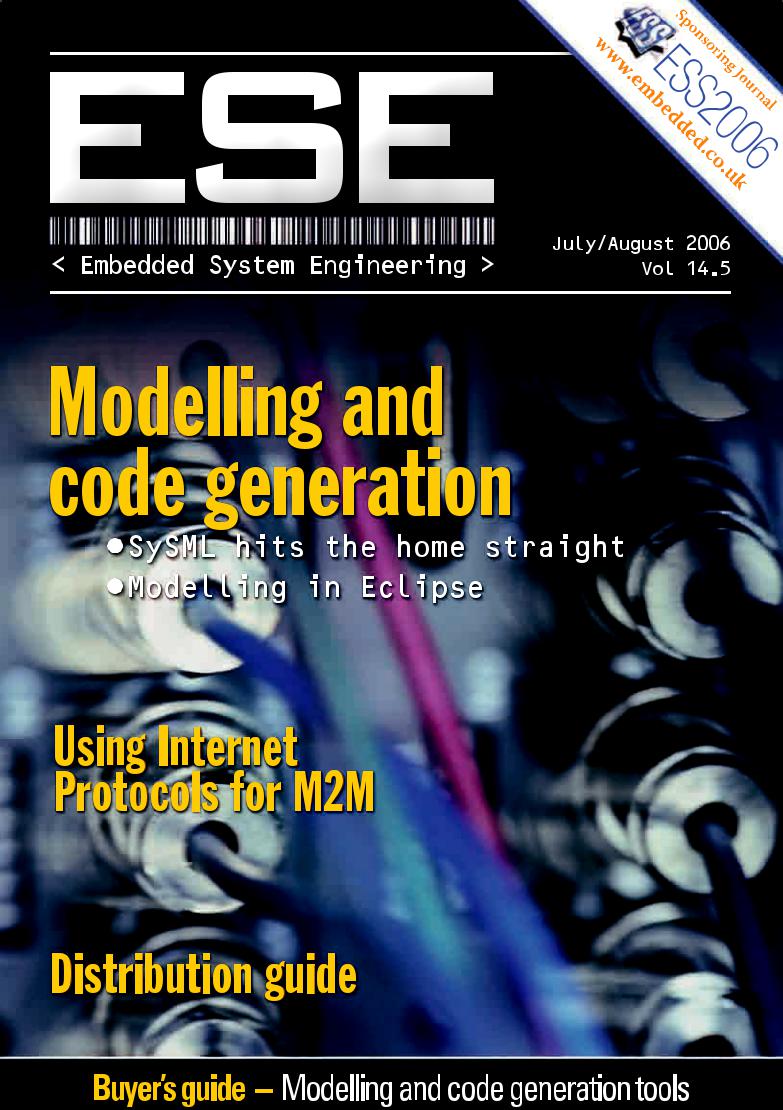

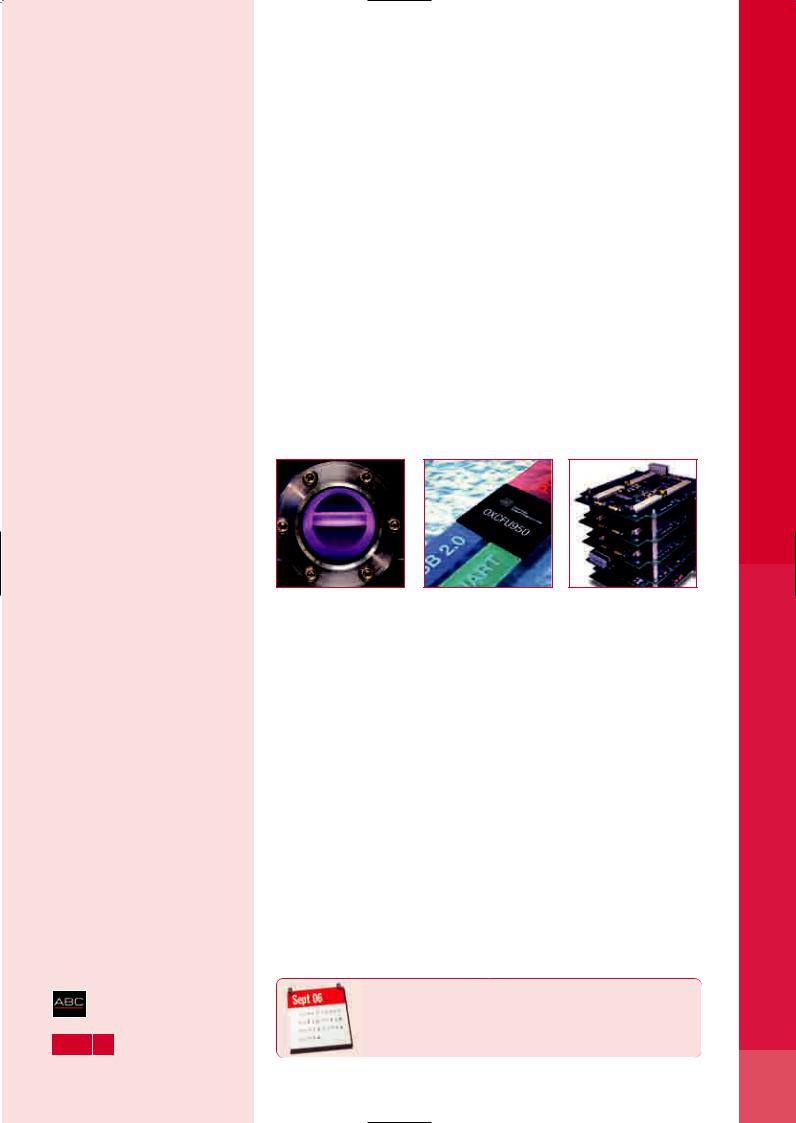
Editorial
Editor:
Dick Selwood
E-mail: ese@edaltd.co.uk
Tel: 0207 681 1000
Consulting Editor:
Martin Whitbread
E-mail: ese@edaltd.co.uk
Managing Editor:
Andrew Porter
E-mail: ese@edaltd.co.uk
Publisher:
Martyn Day
E-mail: ese@edaltd.co.uk
Design & Production
Dave Oswald
E-mail: dave@edaltd.co.uk
Gemma Langdon
E-mail: gemma@edaltd.co.uk
Advertising
Advertisement Manager:
Steve Banks
E-mail: steve@edaltd.co.uk
Financial Director:
Terry Wright
E-mail: accounts@edaltd.co.uk
Subscriptions
Circulation Manager:
Alan Cleveland
E-mail: alan@edaltd.co.uk
Free Subscriptions:
Embedded System Engineering is available on free subscription to UK readers qualifying under the publisher’s terms of control.
Paid Subscriptions:
£15.00 per year (8 editions) in UK and Eire; £28.00 per year in Europe;
£45.00 per year rest of world.
See www.esemagazine.com/register/ for details
Origination
ESE is published by:
Electronic Design Automation Ltd, 63/66 Hatton Garden,
London, EC1N 8SR.
Tel: 020 7681 1000
Fax: 020 7831 2057 E-mail: ese@edaltd.co.uk
Printed in the UK by
The Magazine Printing Company
www.magprint.co.uk
© Electronic Design Automation Ltd Reproduction in whole or part without prior permission from the publisher is strictly prohibited.
E D A
P U B L I C A T I O N S
Embedded System Engineering
July/August 2006
Editorial
Three years in Embedded Technology |
04 |
Outgoing editor Dick Selwood, muses on the future of the industryr |
|
News
Industry |
06 |
Industry news includes a Java benchmark contest, 500 GHz silicon and new ASIC technology |
|
Chips |
08 |
Driving 20 LEDs, a toothbrush MCU, and an MCU with FRAM based memory are among latest chips |
|
Tools |
10 |
A PCI Express analyser, support for Cortex A8 and an RS08 compiler are in the tools news |
|
Boards |
12 |
New boards include explosion-proof displays, COTS FPGA boards and Core Duo compact PCI SBCs.
Technology: Modelling
● SysML hits the home straight |
14 |
● Modelling in Eclipse |
16 |
● Generating full code with DSM |
20 |
● Platform independent embedded applications |
22 |
● Systems and software modelling for safety critical environments |
24 |
● In Depth: System modelling and verification |
26 |
Application Focus: Wireless M2M
● Selecting the right service is key as M2M moves to GPRS |
28 |
● Internet protocols for M2M |
30 |
● Getting the M2M experience |
32 |
Distribution: Wireless M2M
● Distribution in the embedded market |
36 |
● Distribution directory |
38 |
Buyer’s guide
Modelling and code generation tools |
18-21 |
Next Issue: ESS preview, safety critical, embedded boards and modules and a COM Express buyers guide.
</Contents>
ESE Magazine July/August 06
03
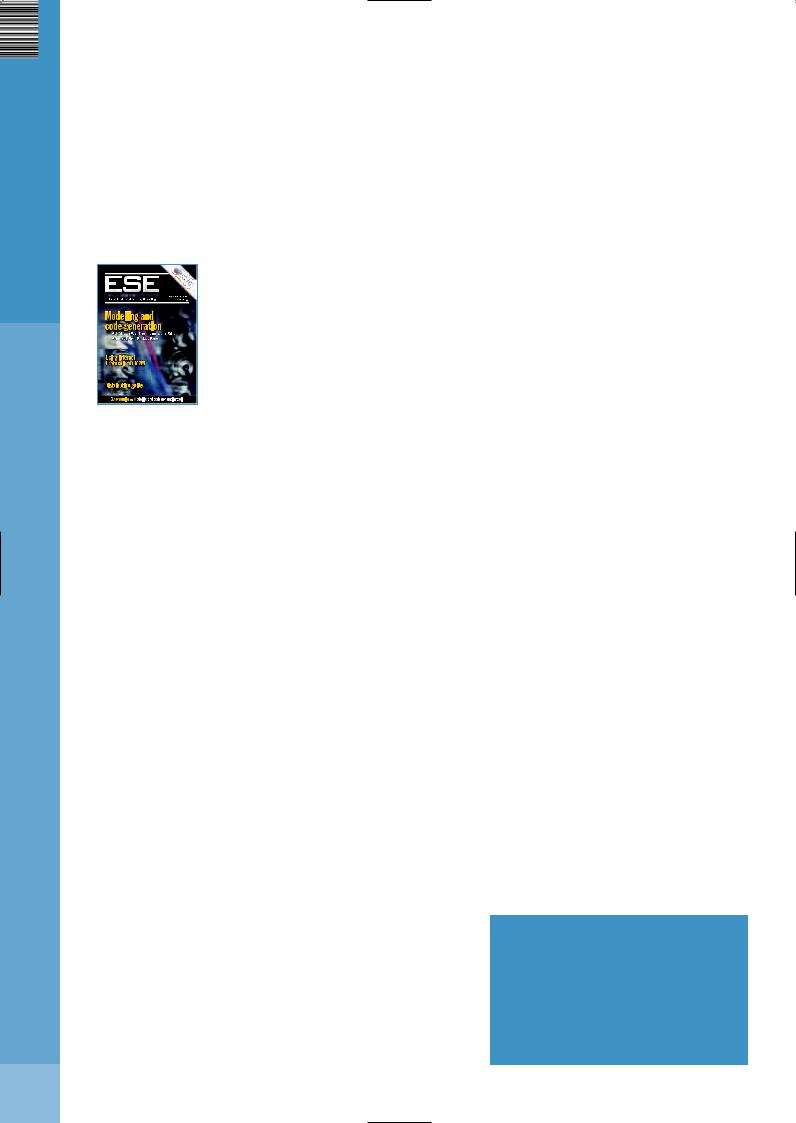
</Editorial>
ESE Magazine July/August 06
4
Editorial comment:
Three years in embedded technology
<Written by> Dick Selwood </W>
A look at the industry after three years in the editor’s chair
One of the stranger things that editors on technical publications find themselves doing is to answer questions from PR firms seeking their views on different aspects of their industry. (The PR compa-
nies use them as the basis for guidance to their customers on forming communications strategy). A few days ago, one of those phone calls was surveying thoughts on both the EDA and the semiconductor industries. As usual, the call came un-announced and the answers were shot from the hip, but afterwards there was time to reflect on the final question, which was roughly, “What is the future for these industries?”
NASDAQ nadir
Three years ago the US technical stock market, as measured by NASDAQ, was at its lowest point after the rupture of the dot.com bubble, with a knock-on effect on all aspects of technology. Greedy investors had swallowed in one gulp business plans that would have been laughed out of existence if they hadn’t had the precious dot.com tag. When the inevitable happened, they reacted to their failures by punishing all technology investments – with the same lack of discernment.
Particularly hard hit were the telcos, who having geared up for internet saw both underused networks and a corresponding drop in their share price, and telecom equipment suppliers, who suddenly had empty order books for as long as networks were running under capacity.
Today that unused capacity – and more – is filling. Broadband is penetrating more and more homes worldwide (50% of UK households is one estimate). It only takes a visit to your local electrical shop to see that the boundary between computers and consumer devices is blurring: convergence is here with combined PCs and TVs, with VOIP boxes and even internet radio devices equipped with WiFi for home distribution as well as sharing the router. Channel 4 is streaming many of its programmes over the web and even Aunty BBC is making programmes available on demand and providing pod casts. And just look at the functionality in today’s 3G slim-line phone/video camera/MP3 player.
will continue to have a role, but the increasing cost and complexity of their development, particularly in a world where standards and protocols are continuing to evolve, means that this role is going to be even more limited. Programmable devices, with the flexibility to match the changing world, are going to be increasingly the product of choice, particularly as more powerful processors become part of the fabric and third party IP continues to improve. But this provides a challenge to the EDA industry. How are they going to persuade the developer to pay the many thousands of dollars that EDA tools have to cost, when they are used to “free” or, at worst, low cost software? And how are the developers going to manage the increasingly complex projects that the new products are going to demand.
One route is in the technical focus of this issue – through modelling and code generation.
SysML
When we planned this issue, it was in the knowledge that the SysML standard was due for discussion by the Object Management Group. In fact, after most of the issue was ready for the printer, OMG announced that it had adopted SysML. Now it is a formal standard you can expect to see more announcements of SysML tools or tools that interface with it, to generate code, for example.
For many smaller projects, modelling has always seemed to be an unnecessary and expensive route, but as the problems to be solved become more complex, so the importance of early accurate definition and also early bug finding and resolution, become more relevant. Code generation may not produce the quality of code that can be written by the very best programmer, but the best tools produce competent code that does the job, and they produce it quickly.
And this brings us back to the starting point. The future for the embedded industry is at least as exciting as it ever has been, and the tools for developing systems, the chips and the design tools, mean that the designer can concentrate on being a designer, creating new and exciting products and letting the tools do the grunt work.
<Ends/>
Good news
All of this is great news for the embedded industry, as innovative engineers come up with even more ways to exploit the Internet, WiFi and consumer electronics. Automotive systems, particularly infotainment, are still growing in power and flexibility and even the industrial sector is seeing growth.
And that brings us back to the semiconductor market. How is it going to serve these new markets? SoCs and ASICs
Red faces
We must apologise to Nallatech for incorrectly giving their URL in the last issue. The one we gave, due to a small production problem, was that of another site. Nallatech’s site is www.nallatech.com

rswww.com/rohs
Trust RS to get RoHS right from the start
You don’t get the ‘RoHS Trusted’ kitemark for nothing! On the contrary, we at RS have gone to great lengths to ensure that you can trust us to meet all your RoHS requirements.
Prevention is always better than cure so don’t risk getting it wrong.
Get it right first time with RS. We’re always ready to come to your Aid - First!
Check out our dedicated website or call us for expert advice – together we can do great things.
|
RoHS Trusted |
08457 201 201 |
Licence No. |
KM500004 |
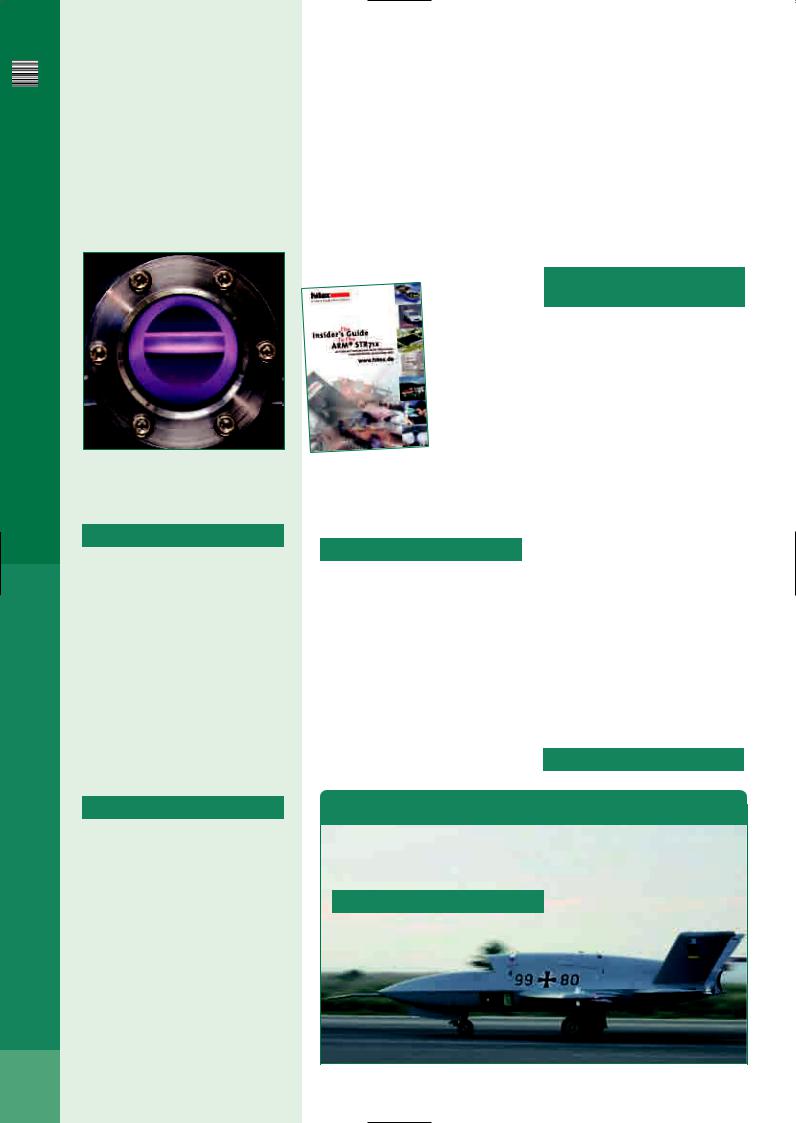
</News - Industry>
ESE Magazine July/August 06
06
Industry
Funding for nanomaterials
THE ADVANCED TECHNOLOGY Institute at the University of Surrey, and its plasma-processing partner CEVP, have been awarded £215,000 project funding from the South East England Development Agency (SEEDA) to help commer-
cialise a prototype tool called NanoGrowth.
This uses the University’s patented production 'recipes' to provide a simple turnkey means of manufacturing highly bespoke nanomaterials.
www.cevp.co.uk/nanogrowth
1394 vs. USB
1394 IS BEING strongly challenged by USB in PC and peripherals markets, but televisions, cable set top boxes, and DVD recorders are all driving 1394a growth in the consumer electronics segment, reports In-Stat Digital. Since the HighDefinition Audio Video Networking Alliance (HANA) has endorsed 1394 as a transmission medium for high-definition content, that may spur adoption of 1394 in home video networks.
In the PC world, 1394 has had success in notebook PCs, but has struggled in corporate desktops, which account for a significant share of PCs sold annually.
www.in-stat.com
Silicon at 500GHz
IBM and the Georgia Institute of Technology have demonstrated the first silicon-based chip capable of operating at frequencies above 500 GHz. They had to cryogenically “freeze” the chip to minus 451 degrees Fahrenheit (less than ten degrees above absolute zero). At room temperature, they operated at approximately 350 GHz and computer simulations suggest that the sili- con-germanium (SiGe) technology used in the chip could ultimately approach 1,000 GHz operation at room temperature
For a more detailed look at these stories please visit
www.esemagazine.com
Introduction to microcontrollers
The Hitex Insider’s Guides to microcontrollers now cover more architectures. As well as the Philips LPC2000, Insider Guides are available for STMicroelectronics STR71x, STR73x, STR91x as well as the Infineon XC166.
These books include a systematic introduction to the fundamental features of special microcontrollers and beside basic processor knowledge, the reader is given step-by-step instructions and program examples, with the aim of providing a rapid development.
They can be used as tutorials as well as reference manuals.
Copies of the manuals can be downloaded for free in a screen-optimised PDF version at www.hitex.com/download.html. A low-cost printable PDF in high resolution is also available.
www.hitex.co.uk
nect to increase gate utilization up to 90%. Die sizes that are about half those of previous 180 nm generation sea-of-gates ASICs and are equal to or better than today’s cell-based technology in a 130 nm process.
Existing designs based on a microcontroller and an FPGA may be directly migrated to an MPCF ASIC in as little as 12 weeks. An example BOM for a one-million gate FPGA with an ARM7-based microcontroller is approximately $15.00: an MPCF single chip with equivalent functionality would be less than $9.00.
www.atmel.com/products/ASIC
/mpcf.asp
$2,000 benchmark contest
EEMBC hopes to attract novel benchmarks for its next version of GrinderBench, a benchmark suite that measures the performance of Java ME implementations on mobile phones, with a contest with prizes of $2,000.
Java ME benchmarks that are selected by the Consortium for GrinderBench 2.0 will meet a rigorous set of criteria, including relevance, originality,
www.grinderbench.com.
Flying Realtime Java
EADS’ BARRACUDA unmanned aircraft has safely completed a maiden flight, operating fully automatically during the entire flight, using the JamaicaVM Java implementation from aicas.
www.eads.com / www.aicas.com
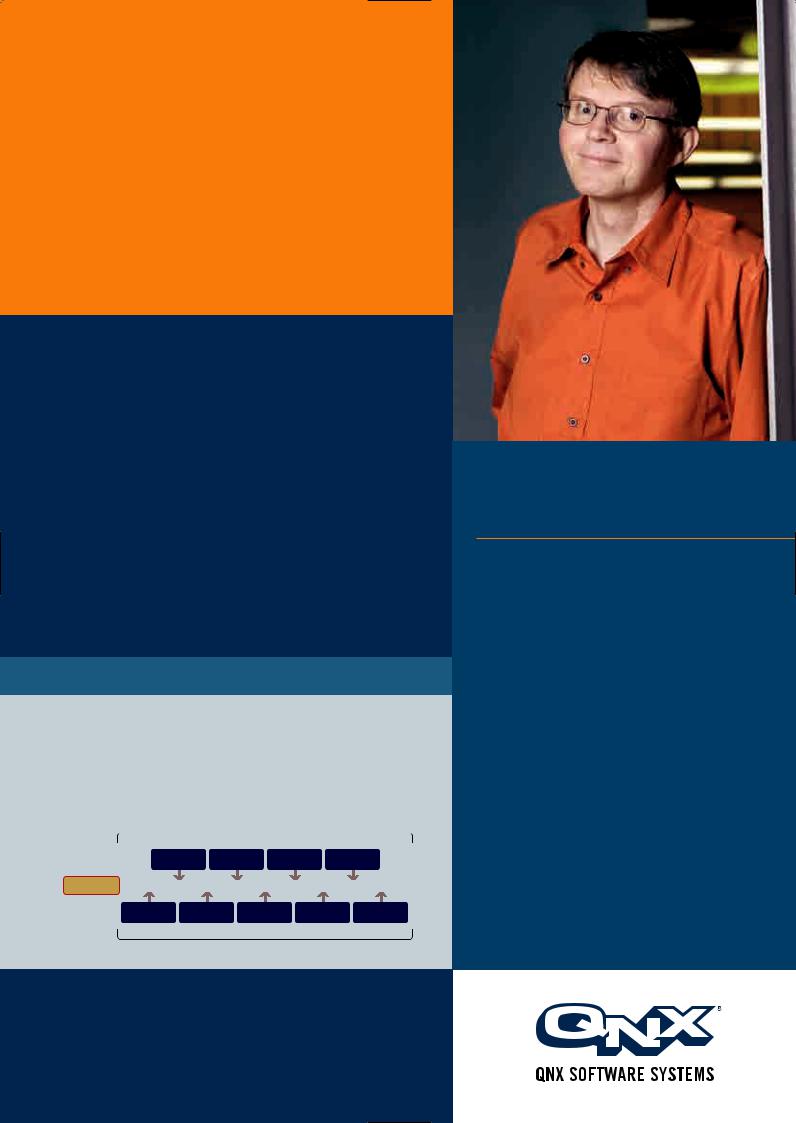
“QNX has consistently defined the leading edge of RTOS technology.”
Dan Dodge. QNX CEO & CTO.
OS architect and father of embedded computing.
Slash your debugging time by weeks, even months, with the QNX® Neutrino® RTOS, the most innovative operating system on the market today. Unlike conventional OSs, QNX Neutrino runs all applications and system services — even device drivers — as memory-protected components. So you can detect memory violations immediately. And focus on what really counts: building innovative features, faster.
Combine this with performance rated #1 in the RTOS market and reliability proven in millions of installations, and you have the platform to power your own leadingedge design.
Focus on Innovation, not Debugging
In the QNX Neutrino RTOS, device drivers, file systems,
and protocol stacks all run outside of the kernel, as memoryprotected processes. This architecture virtually eliminates memory corruptions, mysterious lockups, and system resets. Achieve maximum reliability and put an end to endless debug sessions.
|
|
|
|
|
|
|
Memory Protected |
|
|
Flash |
TCP/IP |
Web Browser |
Serial Device |
||
|
File System |
|
Driver |
||||
|
|
|
|
|
|||
Microkernel |
|
|
|
|
|
|
|
|
|
Message-Passing Bus |
|
|
|
||
|
Media Player |
HTTP Server |
USB Device |
Application |
High Availability |
||
|
|
Driver |
Manager |
||||
|
|
|
|
|
|
||
Memory Protected
Cut your development time. Build longer-lasting products. Gain maximum performance.
Only the QNX Neutrino RTOS gives you:
■Adaptive partitioning to contain security threats and guarantee realtime behavior
■Multi-core, multi-processing support for the ultimate in scalability and performance
■Optimized support for ARM®, MIPS®, PowerPC®, SH-4, XScale®, and x86 processors
■Preintegrated stacks for IPv4, IPv6, IPsec, SNMP, SSH, SCTP, TIPC, IP Filtering and NAT
■Royalty-free kits for multimedia, flash file systems, 3D/2D graphics, web browsers, etc.
■Unparalleled support for open standards: POSIX, Eclipse™, OpenGL® ES, RapidIO®
Discover how Dan and the QNX team can sharpen your competitive edge. Download your free product evaluation from www.qnx.com/innovate.
© 2006 QNX Software Systems GmbH & Co. KG, a Harman International Company. All rights reserved. QNX and Neutrino are trademarks of QNX Software Systems GmbH & Co. KG, registered in certain jurisdictions and are used under license. All other trademarks and trade names belong to their respective owners. 301816 MC339.16
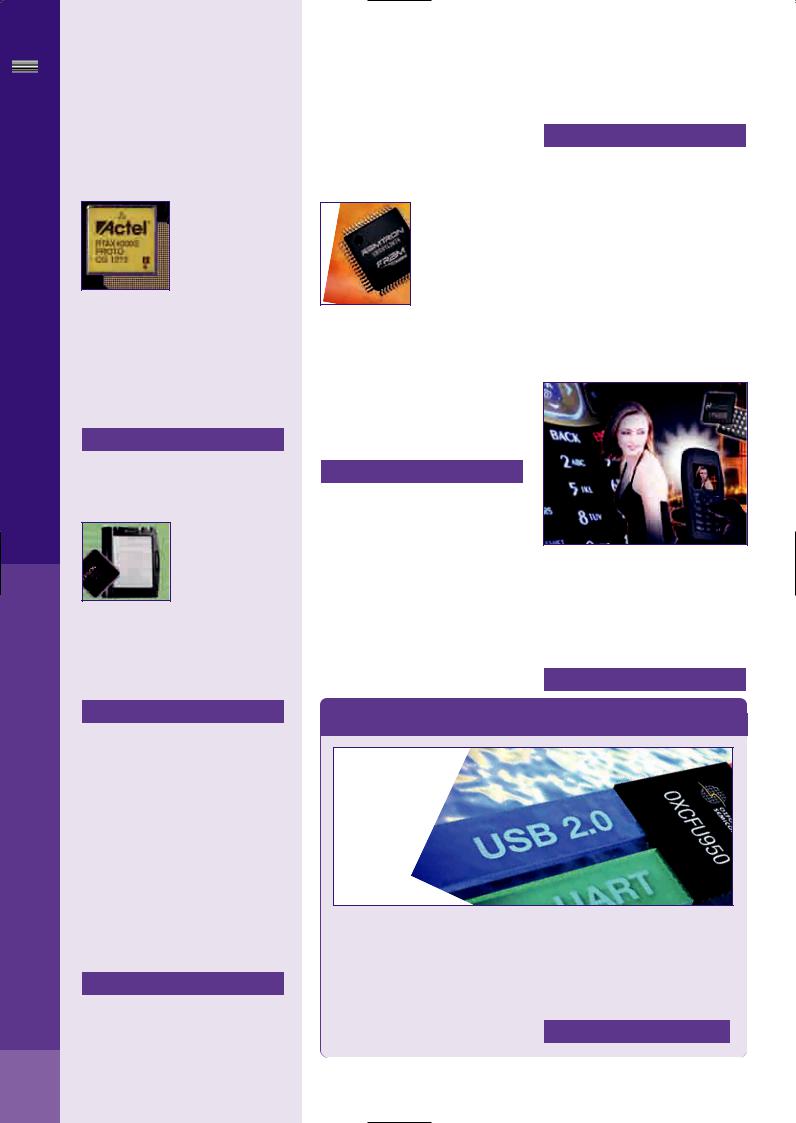
</News - Chips>
ESE Magazine July/August 06
08
Chips
Prototyping space flight FPGAS
ACTEL HAS announced prototypes for the RTAX4000S a four milliongate FPGA for spacebound systems. The proto types have the same
architecture, density and timing properties, and packaging options offered by space flight-quality devices, without the added costs of MIL-STD 883 qualification and hermetically sealed packaging. The RTAX4000S is for high gate-count satellite payload systems, such as data processing applications in communications, earth observation and scientific satellites.
www.actel.com
Processor for e-Books
EPSON HAS developed an application processor, the S1C33E07, for portable devices such as electronic dictionaries and e-books that require high-level data processing and displays. It is a
one-chip solution, integrating functions required for electronic dictionaries and e-books such as a colour LCD control circuit, USB 2.0 device connectivity, and interfaces for electronic media, SDRAM, and NAND flash memory.
www.epson-electronics.de.
8-Bit 6-Pin MCU drives toothbrushes
FREESCALE HAS announced the first product to be built on the recently announced RS08 core, a simplified version of Freescale's high-perform- ance, low-power HCS08 architecture. The MC9RS08KA family is a ultra-low-end, sub-50- cent 8-bit device small enough to fit in the head of an electric toothbrush, designed for applications with extreme space and price constraints, such as traditional electro-mechanical designs and portable applications ranging from motor control to use-and-toss health care products.
www.freescale.com/8bit.
For a more detailed look at these stories please visit
www.esemagazine.com
FRAM-enhanced 8051
Ramtron has launched the VRS51L3074, the first 8051-based microcontroller with nonvolatile FRAM memory.
FRAM simplifies the design cycle by eliminating the code overhead accompanying Flash data storage. FRAM bytes can be modified without first erasing an entire sector FRAM provides virtually unlimited read/write cycles and fast data
writes.
The VRS51L3074 includes 8KB of FRAM memory, an advanced 40-MIPS, single-cycle 8051-core, 64KB Flash with In-System/In- Application Programming, 4KB SRAM, a JTAG program/debug interface, digital signal processing (DSP) extensions and a robust digital peripheral set. Suggested applications range from sensors and metering to industrial control, instrumentation and medical devices.
www.ramtron.com.
NPT-Trench IGBT
The FGA15N120ANTD is available in a lead (Pb)-free TO-3P package.
www.fairchildsemi.com
LMU drives up to 20 LEDs
National has introduced two new, highly integrated lighting management units (LMUs) that include a high-voltage boost converter and programmable constant-cur- rent driver to control up to 20 series-con- nected LEDs in display backlights, and keypad, RGB and camera flash LEDs. The LP3958 and LP5526 LMUs have micro SMD
Fairchild’s new 1200V/15A NPT-Trench IGBT can withstand as much as 300mJ of avalanche energy in induction heating (IH) applications. This helps ensure “rugged” fail-safe operation of the system during abnormal avalanche-mode conditions that commonly affect IH appliances such as microwave ovens, IH rice cookers and other IH cookers.
PC Card to USB and UART
packages and are for cell phones and other handheld devices.
They drive from two to five strings of four series-connected LEDs and each features three GPIOs to trigger lighting functions such as flash or to control additional device-enable signals.
www.national.com.
COMBINING A 16-bit PC Card host interface, a USB 2.0 full speed host controller and a high performance UART, the OXCFU950 from Oxford Semiconductor is for next generation, high speed PC and Compact Flash Cards for 3G cellular, mobile TV and wireless networking applications.
It complies with both PCMCIA revision 8.0
and Compact Flash revision 3.0 standards and integrates a USB 2.0 full speed host controller with an 8kbyte data buffer and Windows or Linux software stacks. The UART offers baud rates up to 12Mbps and is software compatible with the industry standard 16C550 type.
www.oxsemi.com.

Some things
have
to go out
on time
As an embedded software developer, you’re always facing the next deadline. We know it’s important to get your products to market before your competitors, and we can help. With our Eclipse-based development tools, tightly integrated embedded software and support that is second to none, we offer you a partner to get your product to market quickly and easily.
The EDGE Eclipse-based development environment provides a set of top-notch development tools in the industry today. You’ll see how quickly you can code, collaborate on and deliver your final product. Additionally, the Nucleus range of royalty-free RTOS and middleware products gives you a proven kernel with everything else you need in a modern OS. Open, available, affordable solutions.
Finally, our Customer Support has one goal: provide the most experienced, timely and one-on-one customer support in the industry. As the only five-time recipient of the Software Technical Assistance Recognition (STAR) Award for technical support excellence and global support center practices certified by the Support Center Practices (SCP), we are dedicated to your success.
For a free evaluation, visit our website
Mentor.com/embedded or email us at
embedded_info@mentor.com
©2006 Mentor Graphics Corporation. All Rights Reserved.

</News - Tools>
ESE Magazine July/August 06
Tools
ZigBee network stack
JENNIC has announced that it will make its ZigBee network stack object library with all associated support including user guides, programming and reference manuals, and application notes publicly available online on its web site.
www.jennic.com/support
Compiler for RS08
THE BYTE CRAFT C6808 compiler supports the new Freescale RS08 microcontroller. Complete with IDE, compiler, linker and utilities, the compiler has full C support, including ISO18037 support for embedded data types.
RS08 has a slightly different interrupt structure to the rest of the HC08s. and Byte Craft has taken advantage of the change in architecture to introduce a novel threaded programming model in the compiler.
An 84 page overview and programming guide is available.
www.phaedsys.org
IP for LatticeSC FPGAs
LATTICE HAS announced an IP portfolio for the LatticeSC Extreme Performance FPGA family. The portfolio includes forty-four IP cores, including both Lattice-created and third-party blocks. Lattice ispLeverCORE Connection partners CAST, DCD, Elliptic and Northwest Logic have made contributions to the portfolio.
www.latticesemi.com
MATLAB on Windows
Compute Cluster
THE MATHWORKS today announced that the Distributed Computing Toolbox, which extends MATLAB to distributed and parallel applications, now supports Microsoft Windows Compute Cluster Server 2003.
The Distributed Computing Toolbox support for third-party schedulers, such as Microsoft’s Job Scheduler within Windows Compute Cluster Server 2003 and Platform Computing’s Platform LSF, lets users integrate MathWorks distributed computing tools into their existing distributed computing environments.
www.kontron-emea.com
Fixed configuration logic analysers
Agilent has released new fixed-configu- ration logic analysers. The new Agilent 16800 family of analysers has eight logic, all with a 15-inch display and optional touch-screen interface.
Memory depth is up to 32M samples and three models offer an integrated digital stimulus that allows design teams to quickly emulate missing components, inject faults and assist in performing design characterisation.
www.agilent.com.
IP vendors to create a single version of the encrypted data that can be used by tools from multiple EDA vendors and allows IP providers and EDA vendors to deliver solutions to their customers that provide the flexibility and security necessary for an industry standard to emerge. .
www.synplicity.com.
PCI Express analyser
LeCroy has a new low cost PCI Express analyzer. The PETracer Edge is based on a card platform that supports x1/x2/x4 lane widths at 2.5 GB/s speeds and will be offered in two versions: PRO and EXPERT.
EXPERT has deep analysis for error trou-
Open IP encryption
Synplicity has developed a free, non-propri- etary IP encryption methodology, applicable to both FPGA and ASIC design flows, which permits industry-wide interoperability.
Synplicity is offering this methodology to the EDA, IP and end-user communities as a means to address the challenges designers face when using protected IP in their design flows, which are often made up of tools from several different EDA providers. The proposed methodology will allow
bleshooting of bus management and protocol operation issues. For example, users can monitor in real-time various statistics like bus throughput and link utilization for all transactions and packets that occur on a given link.
www.lecroy.co.uk
Cortex A8 Support
THE TRACE32 ICD and TRACE32 PowerTools debuggers from Lauterbach now support the ARM Cortex A8. The Lauterbach TRACE32ICD and PowerDebug modules take advantage of CoreSight, a new ARM standard, for enhanced debugging and trace functionality. With TRACE32 PowerTrace, it is possible to use the ETM CoreSight components to record the program flow of Cortex A8 in real time. In addition, extended NEON instructions and access to the NEON registers are also supported as well as access to the cache and the
MMUs. An unlimited number of software breakpoints in the RAM and flash memories, debugging at HLL and assembler levels, and support of the most widely used C and C++ compilers are standard features.
www.lauterbach.co.uk
10
